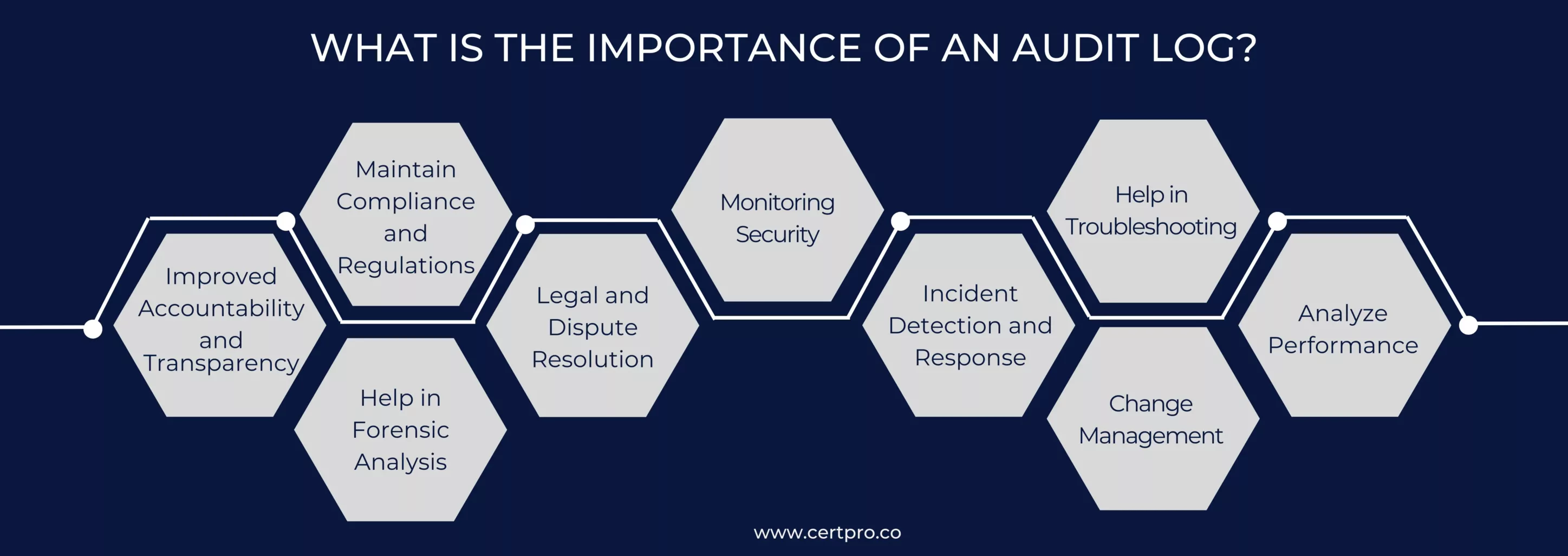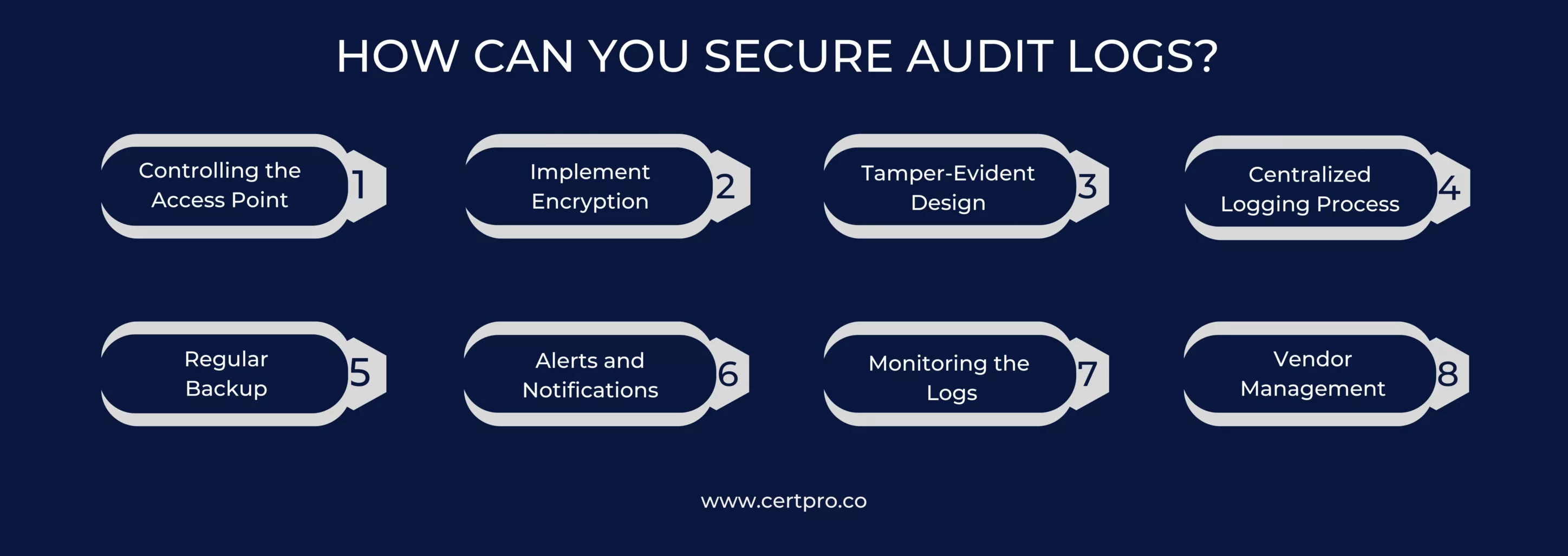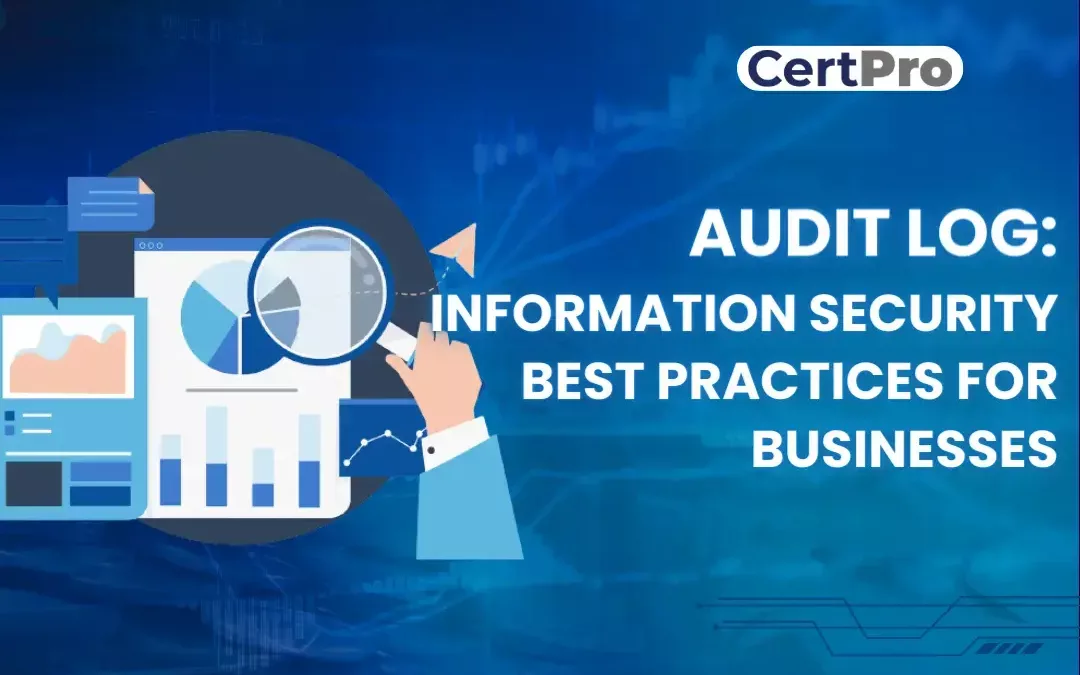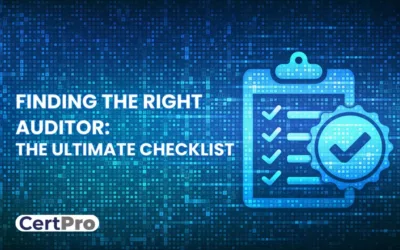An audit log is the best information security practice for organizations. This article elaborates on the operational process of audit logs and how companies utilize them for business growth. What is an audit log, and how does it work for organizations? For more insight, you need to read the article. In brief, effective audit logs enhance accountability, security, and compliance posture.
However, many organizations need to pay more attention to log management. Thus, they need better compliance compatibility, which risks their businesses. This guide explains the significance and purpose of the log. In addition, the differences between the audit log and the system log will be discussed, along with how to secure the log process.
WHAT IS AN AUDIT LOG?
An audit log records events, actions, and organizational changes regarding an organization’s software applications, network, and systems. In simple words, it is the organization’s audit history. The main aim is to maintain an intricate and tampered record of activities. This would help maintain compliance and troubleshoot. In an organization, IT devices create logs based on multiple events. Therefore, logs are records of such events or sequences of specific activities. The operation process of audit trails depends on the device types and operation process.
Moreover, it keeps a complete track record of your operation systems. Thus, administrators and auditors consider them a valuable resource for examining suspicious activities within network systems. Audit trails can be manual or electronic. The log format is as simple as a database table but requires specific structures to avoid confusion. Organizations must have an audit trail review template, which needs to be followed. However, manipulation of logs, misconfiguration, or a corrupted file can make the process useless.
WHAT IS THE IMPORTANCE OF AN AUDIT LOG?
An audit trail improves the organization’s functioning and documentation process. Some other benefits are listed below:
Improved Accountability and Transparency: The process helps develop a straightforward document of users’ activities and systems. Hence, historical records can be used as a future reference during decision-making. Additionally, the record found malicious actions and traced the responsible individuals.
Maintain Compliance and Regulations: Some regulations like HIPAA, GDPR, and PCI DSS require maintaining an audit log of the organizations as a part of their data protection practice. Therefore, audit tails provide evidence of compliance and ensure safe practice.
Help in Forensic Analysis: Audit trails are considered valuable sources of information for forensic analysis. Therefore, security professionals use them to investigate incidents and determine the attack vector.
Legal and Dispute Resolution: In legal disputes, audit logs provide evidence of actions taken during the incident and offer information regarding system interactions. The process can help resolve false allegations about the organization and improve its reputation.
Monitoring Security: The logs record events related to login attempts, access to sensitive data, and system modifications. Thus, they monitor the security posture of the organizations. Furthermore, a prompt response is disseminated to the record of unauthorized access or suspicious activities.
Incident Detection and Response: Audit logs help identify and respond to unauthorized activities in data breaches. Management can investigate and take appropriate action against potential threats if unusual patterns are detected in the audit trail.
Help in Troubleshooting: It helps diagnose technical issues by offering insights into the system’s behavior and performance checking. Thus, the IT teams can recognize the causes of anomalies and fix the problem.
Change Management: Another crucial function of audit logs is tracking configuration changes and system modifications. Therefore, they help manage IT and ensure the organization recognizes potential risks.
Analyze Performance: The report also examines system usage, resource consumption, and user behavior. Thus, it can be utilized to optimize performance and resource management.

THE DIFFERENCE BETWEEN A SYSTEM LOG AND AN AUDIT LOG
System logs and audit logs help monitor the security of your organization’s computer, network, and applications. However, both logs are different and record distinctive information. System logs provide information about system operation and performance. Nevertheless, audit logs focus on recording security-related issues to enable compliance and an organization’s security posture. In addition, it helps in the forensic analysis and monitoring of security incidents. Furthermore, both systems maintain the overall health and security of computers and networks.
Audit logs record security-related information that is utilized to improve organizations’ security stance. At the same time, system logs record information related to system errors or networks. Thus, auditors can use the audit logs for their auditing process, whereas system logs provide information to system administrators. Therefore, the organization can activate or deactivate the audit trails as needed. Some organizations activate the logs before the audit and detective the logs in between the audits. However, system logs cannot be deactivated. It is a continuous process of recording. In addition, logs may contain personal information that falls under the data protection regulations, while system logs do not contain any personal information.
HOW CAN YOU SECURE AUDIT LOGS?
Securing audit logs ensures the integrity, confidentiality, and availability of data. Therefore, it prevents unauthorized access to data and avoids the risk of data manipulation.
Controlling the Access Point: Limiting access to audit logs. Thus, role-based access controls help in controlling the access point. In addition, multi-factor authentication enables the authorized use of data.
Implement Encryption: Encryption protects against data interception and unauthorized access. Therefore, encrypting logs in transit and at rest provides robust security.
Tamper-Evident Design: Execution of controls to ensure the integrity of the audit trail and prevent unauthorized access and manipulation of data. In this regard, digital signatures can ensure data safety in audit logs.
Centralized Logging Process: Centralized logging solutions to collect and store the audit logs. Hence, it is easier to monitor and protect the logs dispersed across various systems.
Regular Backup: Redundant copies of audit logs ensure data safety by preventing data losses due to hardware failures. In cases of disasters or cyberattacks, the data remains safe and untouched. Henceforth, regular backup of audit logs ensures the recoverability of data and the restoration process.
Alerts and Notifications: Implement measures to monitor the audit logs for suspicious activities and unauthorized access. The audit trail process must have an alert or notification system for potential risks.
Monitoring the Logs: Regularly monitoring the log process ensures data safety. In addition, periodic audits and reviews confirm that the logs are working appropriately.
Vendor Management: Third-party logging solutions ensure the organization follows robust security measures and compliance regulations.

HOW OFTEN DO YOU REVIEW AN AUDIT LOG?
Organizations follow scheduled and event-triggered reviews for audit logs. Regular schedule reviews can follow daily, weekly, monthly, or quarterly audits, depending on the organization’s demands. Therefore, such reviews enable ongoing monitoring and ensure compatibility with compliance. Conversely, event-triggered reviews may be performed by specific events like system updates, emerging new threats, and security incidents. The events require audits to assess their impact.
In addition, some compliance regulations require audit log reviews to ensure the organization meets the requirements. In some instances, business partnerships also require the review of audit logs. High-risk systems require frequent audits and monitoring. Furthermore, high event volumes or incidents require frequent reviewing. Again, frequent system upgrades demand log reviews. Therefore, organizations can implement automated tools to analyze the logs. Moreover, the organization’s size will determine how frequently the audit process can be achieved. The process requires resources and a dedicated team to continue the audit process.
FINAL THOUGHTS
An audit trail is the easiest yet most effective way to track an organization’s information. It enables the recording of events that happened. Therefore, the process needs to be stored in a central place where it can be searched and analyzed. It is an effective measure to secure the data history that can be used during the audit process. Audit log best practices help detect security violations and application flaws that result in non-compliance.
FAQ
What points need to be incorporated in an audit log?
It depends on the organization’s requirements. However, you can incorporate time, location, event description, and action types. In addition, audit logs can have data access and authentication information, error details, and device identification.
Why is the use of an audit log?
It is used to keep records that are considered evidence of certain events or procedures. The primary aim is to reduce fraud, remove errors, and prevent unauthorized data manipulation.
What can you do with audit logs?
Audit logs signify that your organization follows specific procedures for data recording and contain a detailed history of system outrage and incidents.
What are the types of audit logs?
Usually, two audit logs are obtained: event-oriented logs and keystroke monitoring.
What are the disadvantages of audit logs?
The automated audit logs require expert suggestions and expensive maintenance. In addition, more extensive logs create challenges in managing and auditing the data.

About the Author
ANUPAM SAHA
Anupam Saha, an accomplished Audit Team Leader, possesses expertise in implementing and managing standards across diverse domains. Serving as an ISO 27001 Lead Auditor, Anupam spearheads the establishment and optimization of robust information security frameworks.
FINDING THE RIGHT AUDITOR: THE ULTIMATE CHECKLIST
Selecting an auditor to implement industry-specific rules and regulations is vital. The choice can influence the company’s growth and financial health. Therefore, choosing the right auditor offers valuable insights and ensures compliance and economic stability. You...
AI Audit Guidelines and Best Practices: Applying AI Towards Its Full Potential
Artificial Intelligence is entering different industries, where it is used for customer handling, data management, and documentation processes. The interference of AI is increasing concerns regarding ethical practice and safety. Therefore, AI audits have become more...
MASTERING IN SECURITY AUDIT IN 2024: BEST PRACTICES FOR BUSINESSES
A security audit is essential for companies to maintain robust information security controls. Therefore, audits become more relevant as the number of incidents of data breaches increases. A study suggested that, from 2021 to 2022, the average cost of data breaches...




